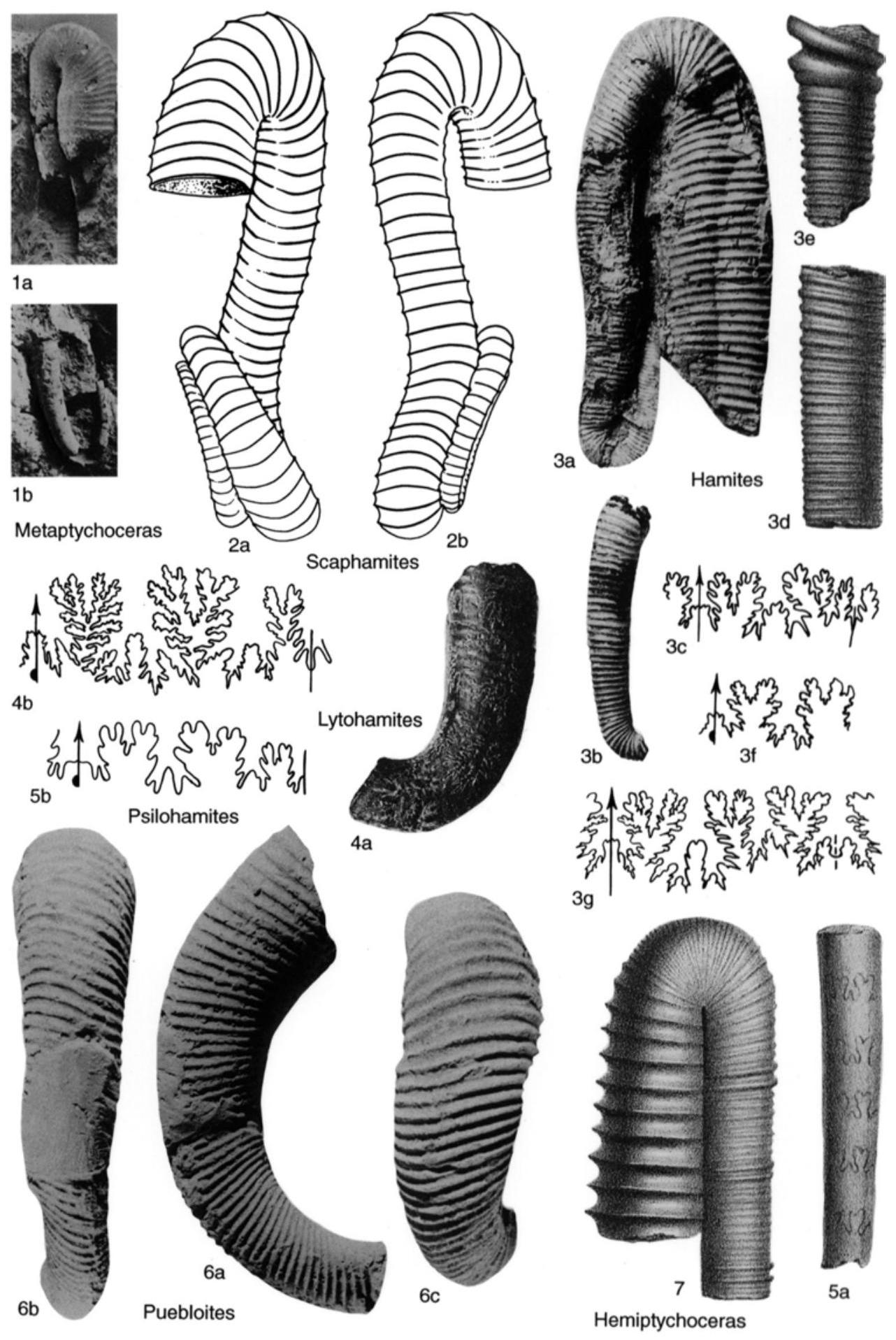Welcome to the Treatise on Invertebrate Paleontology!
Please enter a genera name to retrieve more information.

Hamites
Classification
Phylum:
Mollusca
Class:
Cephalopoda
Subclass:
Ammonoidea
Order:
Ammonitida
Suborder:
Ancyloceratina
Superfamily:
Turrilitaceae
Family:
Hamitidae
Formal Genus Name and Reference:
Hamites PARKINSON, 1811, p. 145
Type Species:
H. attenuatus J. Sowerby, 1814b, p. 137, SD DIENER, 1925, p. 65
Images
(Click to enlarge in a new window)
FIG. 188,3a–c. *H. (H.) attenuatus, Middle Albian, England; a,b, ×1; c, enlarged (Spath, 1923–1943).——F IG. 188,3d–g. H. (H.) duplicatus P ICTET & CAMPICHE, Upper Albian, France; d,e, microconch, ×1 (Pictet, 1847); f,g, × 3 (Spath, 1923-1943).
Synonyms
Torneutoceras; Stomohamites; Hamitella
Geographic Distribution
Europe, Africa, Madagascar, India, Australia (Northern Territory), New Zealand, USA, Mexico
Age Range
Beginning Stage in Treatise Usage:
Lower Cretaceous (Lower Albian)
Beginning International Stage:
Albian
Fraction Up In Beginning Stage:
0
Beginning Date:
113.2
Ending Stage in Treatise Usage:
Upper Cretaceous (Upper Cenomanian)
Ending International Stage:
Cenomanian
Fraction Up In Ending Stage:
100
Ending Date:
93.9
Description
Typically with 3 well-separated, subparallel shafts, but initial spiral or even helical coiling may persist, whorl section circular, depressed or compressed, straight, rectiradiate or oblique ribs typically fine and dense to coarse and distant, but may be obsolescent. Suture florid to rather simple, with wide, bifid L and smaller, trifid or subbifid U. Forms with strong apertural collar and constriction (Stomohamites) are microconchs, their sutures are not consistently different.
References
Museum or Author Information
Classification
Phylum:
Mollusca
Class:
Cephalopoda
Subclass:
Ammonoidea
Order:
Ammonitida
Suborder:
Ancyloceratina
Superfamily:
Turrilitaceae
Family:
Hamitidae
Formal Genus Name and Reference:
Hamites PARKINSON, 1811, p. 145
Type Species:
H. attenuatus J. Sowerby, 1814b, p. 137, SD DIENER, 1925, p. 65
Images
(Click to enlarge in a new window)
FIG. 188,3a–c. *H. (H.) attenuatus, Middle Albian, England; a,b, ×1; c, enlarged (Spath, 1923–1943).——F IG. 188,3d–g. H. (H.) duplicatus P ICTET & CAMPICHE, Upper Albian, France; d,e, microconch, ×1 (Pictet, 1847); f,g, × 3 (Spath, 1923-1943).
Synonyms
Torneutoceras; Stomohamites; Hamitella
Geographic Distribution
Europe, Africa, Madagascar, India, Australia (Northern Territory), New Zealand, USA, Mexico
Age Range
Beginning Stage in Treatise Usage:
Lower Cretaceous (Lower Albian)
Beginning International Stage:
Albian
Fraction Up In Beginning Stage:
0
Beginning Date:
113.2
Ending Stage in Treatise Usage:
Upper Cretaceous (Upper Cenomanian)
Ending International Stage:
Cenomanian
Fraction Up In Ending Stage:
100
Ending Date:
93.9
Description
Typically with 3 well-separated, subparallel shafts, but initial spiral or even helical coiling may persist, whorl section circular, depressed or compressed, straight, rectiradiate or oblique ribs typically fine and dense to coarse and distant, but may be obsolescent. Suture florid to rather simple, with wide, bifid L and smaller, trifid or subbifid U. Forms with strong apertural collar and constriction (Stomohamites) are microconchs, their sutures are not consistently different.
